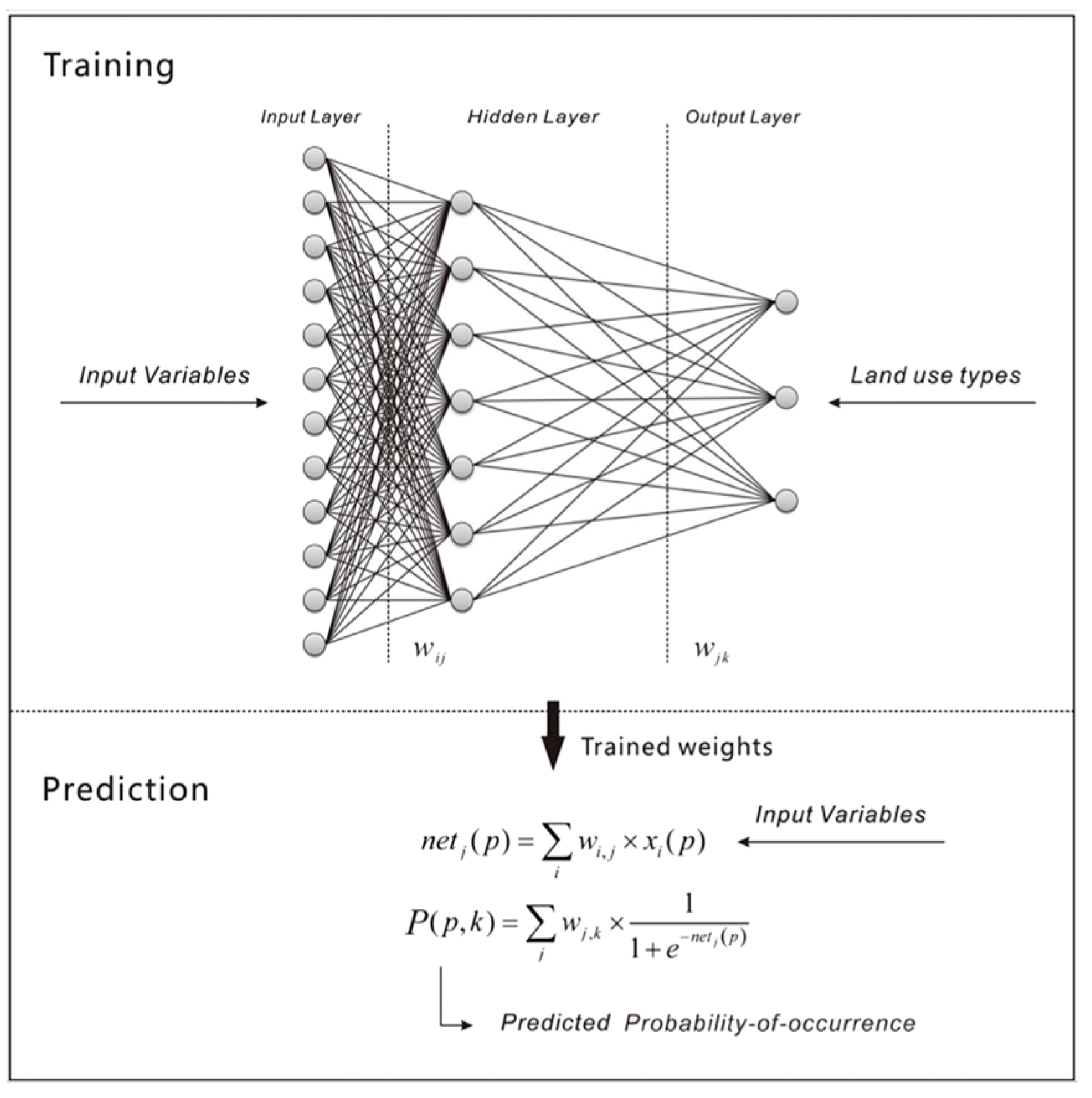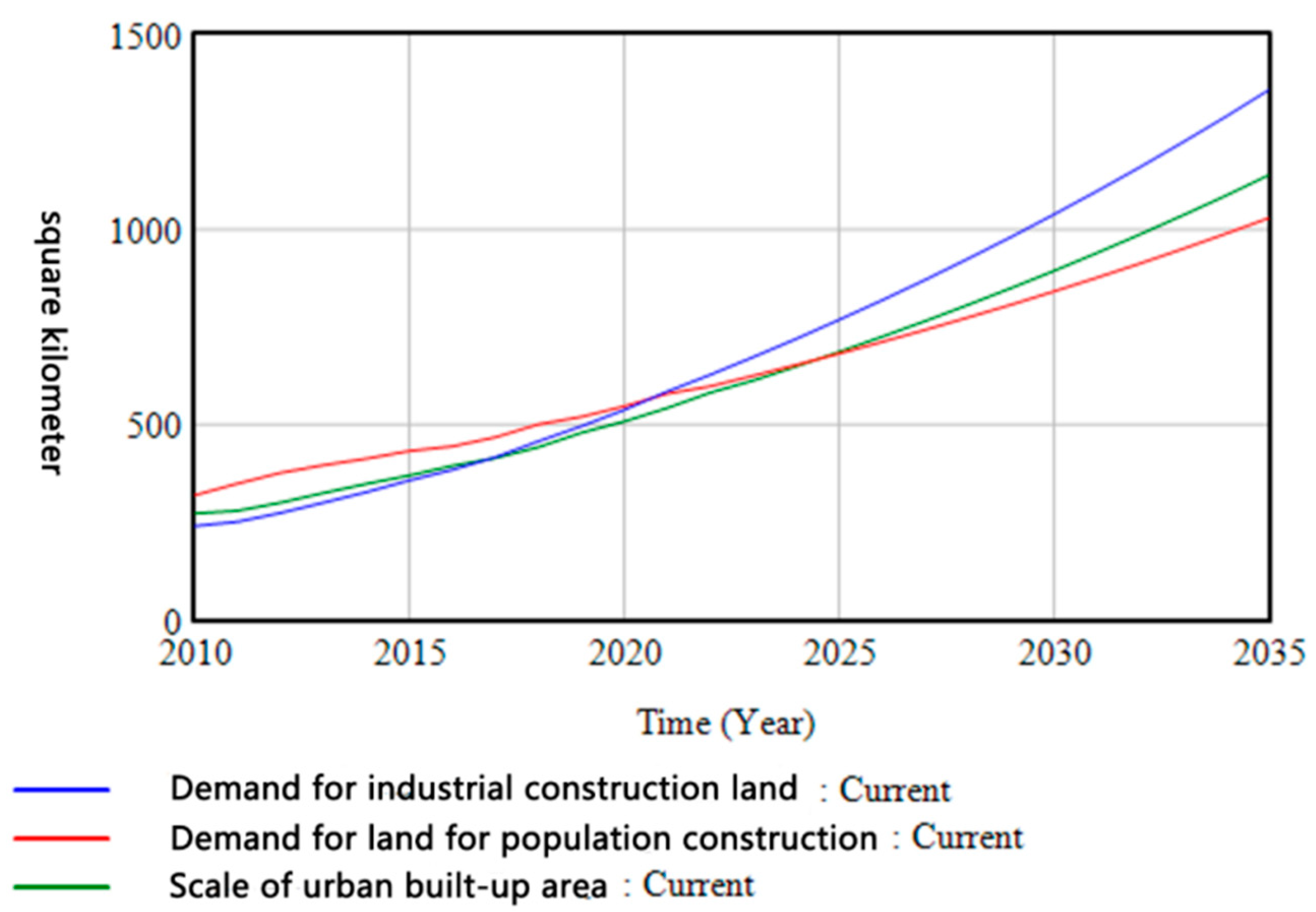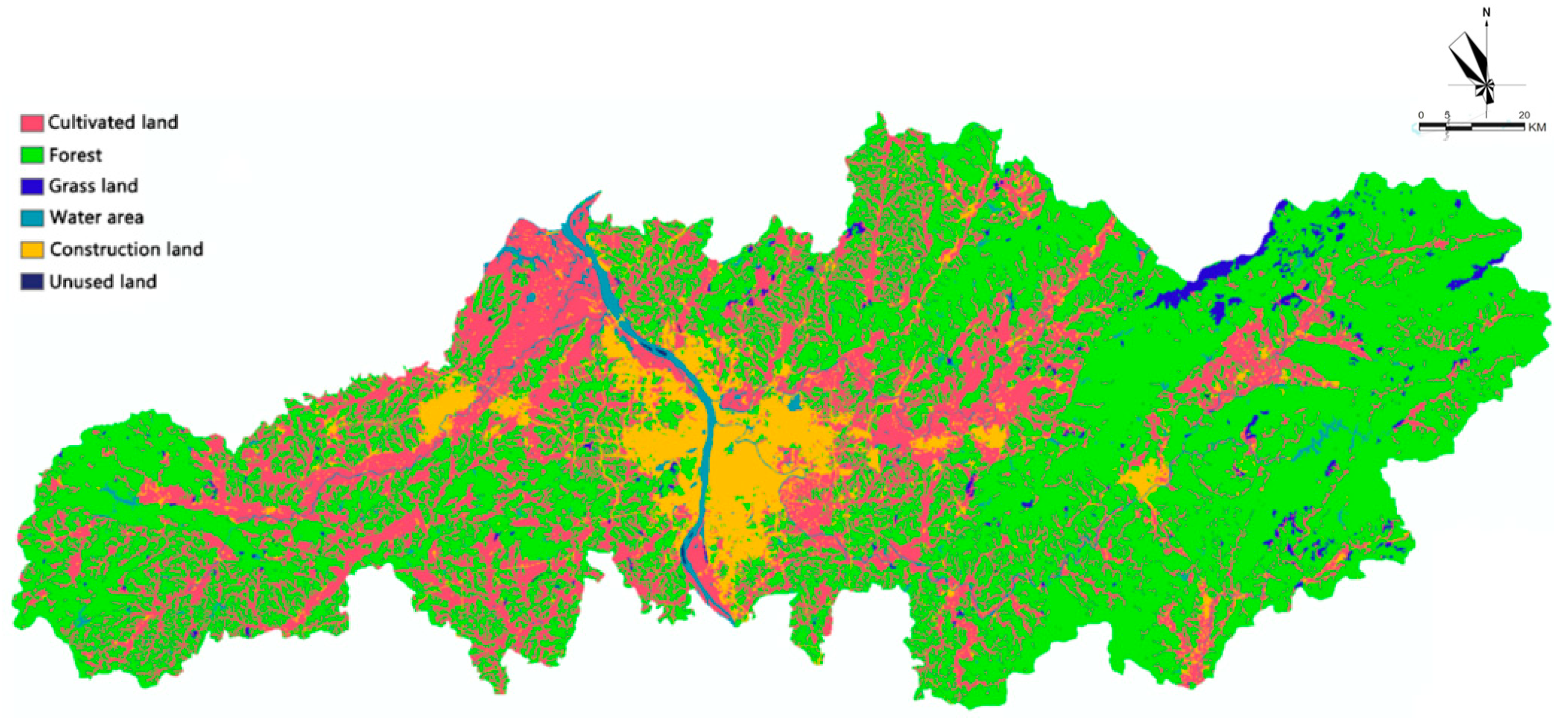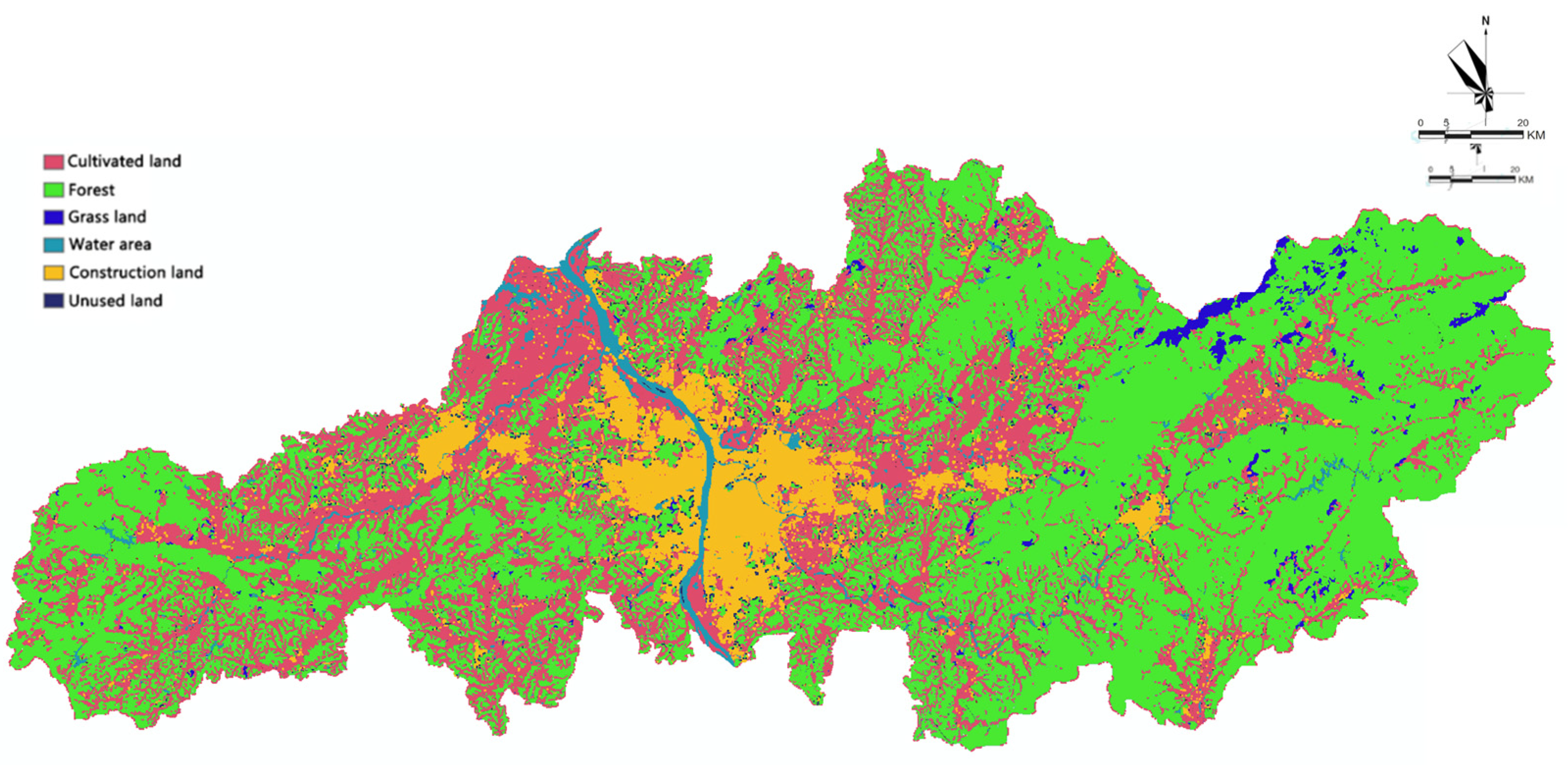Land-Use Assessment and Trend Simulation from a Resilient Urban Perspective: A Case Study of Changsha City
Abstract
:1. Introduction
2. Research Methodology
2.1. Construction of an Urban Resilience Evaluation System
2.1.1. Selection of Resilience Indicators
2.1.2. Determination of Indicator Weights
2.2. System Dynamics (SDs) Model
2.3. FLUS Model
2.3.1. Probabilistic Simulation for Suitability Calculation
2.3.2. The Cellular Automata with Adaptive Inertia Competitive Learning
3. Overview of the Study Area and Data Sources
3.1. Overview of Changsha City
3.2. Data
4. Results and Analysis
4.1. Results of the Urban Resilience Evaluation
4.2. Construction Land Scale Prediction Based on the SD Model
4.2.1. System Dynamics Model Testing and Correction
4.2.2. Simulation and Modeling of the SD Model
4.3. Simulation of Land-Use Layout Based on FLUS Model
4.3.1. Calculating Suitability Probability Based on Neural Network
4.3.2. Cellular Automaton Simulation Based on Adaptive Inertia Mechanism
5. Conclusions
- Although the selection of indicators in this project has been as extensive as possible, the strict rules and the accuracy of data acquired suggest that there are certain shortcomings in the prediction of low-utility land and the decomposition of land-use indicators, and the accuracy of the outcomes of prediction and analysis needs to be improved.
- This project only predicts the urban development stage and construction land scale in Changsha, and it is necessary to further expand the scope of the study to the whole province in the future, so as to analyze in more depth the expansion mechanism of urban construction land scale in each city of Hunan Province under the guidance of resilience, and to provide more active and stable solutions and measures for the high-quality evolution of their urban systems.
- This study adopts the research method of coupling the SD model with the FLUS model, which can compensate for the deficiency of dynamic changes in factors in urban scale prediction. However, this study only focuses on using Changsha as a case study, lacking comparisons with the application of multiple cities and comparisons with various similar models. These aspects should be the focus of future efforts.
- Under the guidance of the concepts of putting people first, constructing a resilient city and ecological civilization, how to establish the evaluation index system of urban construction land scale expansion and quality growth from the perspectives of theoretical connotation, coverage, and consistency of expression.
- In view of the long history of China’s urban development and planning and construction, obtaining long-term historical data for a longer period of research on dynamic monitoring and model simulation of urban system operation process is needed.
- In order to systematically reveal the influencing factors of urban construction land scale prediction and their mechanism of action, quantitative measurement research of specific factors combined with the qualitative analysis mentioned in the paper is needed to provide a basis for formulating diversified effective measures and paths to promote the rationality of urban land scale and layout.
- In the next step, we can further develop the two achievements of “Operation Guide for Urban Development Potential Evaluation” and “Technical Guidelines for Urban Land Simulation Delineation” to assist the province to do great in technological innovation in land-use management, while the algorithm model can be further optimized and integrated with the one map system of land space, which can realize the annual monitoring and prediction of land use and assist in adjusting annual land supply plan and planning construction land scale prediction. Based on this, further research work can be carried out in an urban development potential model, urban land correction model, urban land scale index decomposition model, etc., to deepen the research achievements and improve the application value of them.
Author Contributions
Funding
Institutional Review Board Statement
Informed Consent Statement
Data Availability Statement
Conflicts of Interest
References
- Shao, Y.; Xu, J. Urban Resilience: A Conceptual Analysis Based on International Literature Review. Int. Urban Plan. 2015, 30, 48–54. [Google Scholar]
- Seto, K.C.; Ramankutty, N. Hidden linkages between urbanization and food systems. Science 2016, 352, 943–945. [Google Scholar] [CrossRef] [PubMed]
- Chen, G.; Diao, C.; Huang, M.; Li, M. Study on Prediction of Urban Construction Land in Chongqing City. Resour. Environ. Yangtze Basin 2002, 11, 403–408. [Google Scholar]
- Li, A. Study on Urban Built-Up Area Expansion and Land Use Scale Based on Remote Sensing Images. Ph.D. Thesis, PLA Information Engineering University, Zhengzhou, China, 2009. [Google Scholar]
- Zhu, M.; Wang, W. Prediction of Urban Construction Land Demand—A Case Study of Jiujiang City. J. Southwest Univ. Nat. Sci. Ed. 2015, 40, 74–79. [Google Scholar]
- Liu, K. Application of Principal Component Analysis-Based BP Neural Network in Predicting Urban Built-Up Area: A Case Study of Beijing. Prog. Geogr. 2007, 26, 129–137. [Google Scholar]
- Galster, G.; Hanson, R.; Ratcliffe, M.R.; Wolman, H.; Coleman, S.; Freihage, J. Wrestling sprawl to the ground: Defining and measuring an elusive concept. Hous. Policy Debate 2001, 12, 681–717. [Google Scholar] [CrossRef]
- Ewing, R.; Pendall, R.; Chen, D. Measuring sprawl and its transportation impacts. Transp. Res. Rec. 2003, 1831, 175–183. [Google Scholar] [CrossRef]
- Hasse, J.E.; Lathrop, R.G. Land resource impact indicators of urban sprawl. Appl. Geogr. 2003, 23, 159–175. [Google Scholar] [CrossRef]
- Cong, P.; Jia, Y.; Wang, Q. Prediction of urban built-up land based on nonlinear orthogonal regression model. Geogr. Geo-Inf. Sci. 2008, 24, 75–79. [Google Scholar]
- Qiao, L.; Zhou, W.; Cao, Y. Prediction of urban built-upland based on two factors—Taking Lanzhou City as an example. Resour. Ind. 2010, 12, 100. [Google Scholar]
- Guo, J.; Ou, M.; Liu, Q.; Ou, W. Prediction of construction land demand in Nantong City based on BP neural network. Resour. Sci. 2009, 31, 1355–1361. [Google Scholar]
- Li, A.; Lv, A.; Li, G.; Yu, C. Research on Forecasting Urban Built-Up Area Size Considering Multiple Factors—Taking Zhengzhou City as An Example. Bull. Surv. Mapp. 2009, 53, 26–28. [Google Scholar]
- Li, Y. Study on the Influencing Factors and Maximum Scale of Urban Land Expansion in Zhengzhou City. Ph.D. Thesis, Henan University, Zhengzhou, China, 2011. [Google Scholar]
- Yang, X.; Yang, J.; He, L. Logical delineation of urban development boundaries: Scale, form and governance—Also on the technical basis for national land spatial planning reform. Planner 2019, 35, 63–68. [Google Scholar]
- Zhang, L.; Zeng, H. Main model types and characteristics of urban construction land growth prediction. Geogr. Geo-Inf. Sci. 2014, 30, 50–55. [Google Scholar]
- Yu, K.; Zhou, N.; Li, D. A new idea for urban land scale prediction: A consideration from the industrial level. City Plan. Rev. 2004, 28, 62–65. [Google Scholar]
- Wang, Q. New Advances in Theory and Method of System Dynamics. Syst. Eng.-Theory Pract. 1995, 4, 6–12. [Google Scholar]
- Wang, L.; Cen, Y.; Li, R.; Xie, N.; Song, C. Study on cellular automata land use evolution model based on block characteristics. Geogr. Geo-Inf. Sci. 2009, 25, 74–76. [Google Scholar]
- Yang, X.; Liu, Y.; Wang, X.; Duan, T. A Constrained Cellular Automata Model for Land Use Planning and Layout. Geomat. Inf. Sci. Wuhan Univ. 2007, 12, 64–67. [Google Scholar]
- Liu, X.; Liang, X.; Li, X.; Xu, X.; Ou, J.; Chen, Y.; Li, S.; Wang, S.; Pei, F. A future land use simulation model (FLUS) for simulating multiple land use scenarios by coupling human and natural effects. Landsc. Urban Plan. 2017, 168, 94–116. [Google Scholar] [CrossRef]
- Liu, X.; Li, X.; Peng, X. Application of “niche” cellular automata inland sustainable planning model. Acta Ecol. Sin. 2007, 27, 2391–2402. [Google Scholar]
- Zhang, Y.; Liao, H.; Li, Y. Research on Urban Growth Boundary Delimitation Based on Counter Planning and FLUS Model—A Case Study of Yubei District in Chongqing City. Resour. Environ. Yangtze Basin 2019, 4, 757–767. [Google Scholar]
- Chen, Y.; Li, X.; Liu, X.; Ai, B.; Li, S. Capturing the varying effects of driving forces over time for the simulation of urban growth by using survival analysis and cellular automata. Landsc. Urban Plan. 2016, 152, 59–71. [Google Scholar] [CrossRef]
- Li, G. Research on Land Use Change and Simulation of Shenzhen City Based on FLUS Model. Master’s Thesis, Wuhan University, Wuhan, China, 2018. [Google Scholar]
- Rahim, F.H.A.; Hawari, N.N.; Abidin, N.Z. Supply and demand of rice in Malaysia: A system dynamics approach. Int. J. Supply Chain. Manag. 2017, 4, 234–240. [Google Scholar]
- Portela, R.; Rademacher, I. A dynamic model of patterns of deforestation and their effect on the ability of the Brazilian Amazonia to provide ecosystem services. Ecol. Model. 2001, 143, 115–146. [Google Scholar] [CrossRef]
- Cutter, S.L.; Barnes, L.; Berry, M.; Burton, C.; Evans, E.; Tate, E.; Webb, J. A place-based model for understanding community resilience to natural disasters. Glob. Environ. Chang. 2008, 18, 598–606. [Google Scholar] [CrossRef]
- David, R.; Goldschalk, C.H. Urban disaster mitigation: Creating resilient cities. Int. Urban Plan. 2015, 30, 22–29. [Google Scholar]
- Li, Y.; Zhai, G. Research on China’s urban disaster resilience assessment and its enhancement strategy. Planner 2017, 33, 5–11. [Google Scholar]
- Xie, X.; Zheng, Y. Research on evaluation index system of climate-adapted cities—Taking Beijing as an example. Urban Environ. Res. 2016, 5, 50–66. [Google Scholar]
- Dai, W.; Sun, Y.; Han, M. A study on resilience planning for delta cities under climate change. Urban Plan. 2017, 41, 26–34. [Google Scholar]
- He, J.; Meng, Y.; Zheng, P. Progress and Trends of Urban Resilience Governance Research in China (2000–2021)—A Visualization Analysis Based on CiteSpace V. Disaster Sci. 2022, 37, 148–154. [Google Scholar]
- Zhang, J.; Fan, L.; Zhang, Z.; Yu, W.; Zhu, L. Research and practice on safety resilience impact assessment of megacities under multiple hazards. Disaster Sci. 2023, 38, 7–12. [Google Scholar]
- Zhang, M.; Feng, X. Comprehensive evaluation of China’s urban resilience. Urban Issues 2018, 10, 27–36. [Google Scholar]
- Chen, W.; Xia, J. An optimal combination assignment method synthesizing subjective and objective weighting information. Pract. Recognit. Math. 2007, 1, 17–22. [Google Scholar]
- Zhang, X.; Li, A.; Nancy; Lei, G.; Wang, C. Multi-scenario simulation of land use change in China-Pakistan Economic Corridor based on coupled FLUS-SD model. J. Geo-Inf. Sci. 2020, 22, 2393–2409. [Google Scholar]
- Gu, M.; Ye, C.; Hu, M.; Lyu, X.; Li, X.; Hu, H.; Huang, X. Multi-scenario simulation of land use change based on MCR-SD-FLUS model: A case study of Nanchang, China. Trans. Gis 2022, 26, 2932–2953. [Google Scholar] [CrossRef]
- Wang, X.; Che, L.; Zhou, L.; Xu, J. Spatio-temporal Dynamic Simulation of Land use and Ecological Risk in the Yangtze River Delta Urban Agglomeration, China. Chin. Geogr. Sci. 2021, 31, 829–847. [Google Scholar] [CrossRef]
- Liang, X.; Liu, X.; Li, D.; Zhao, H.; Chen, G. Urban growth simulation by incorporating planning policies into a CA-based future land use simulation model. Int. J. Geogr. Inf. Sci. 2018, 32, 2294–2316. [Google Scholar] [CrossRef]
- Geng, S.; Yang, Z.; Dang, X.; Sui, B.; Cao, X.; Li, P.; Zheng, Z. Multi-scenario simulation of land use in Ningxia based on SD-FLUS model. J. Earth Sci. Environ. 2023, 45, 806–818. [Google Scholar]
- Wei, X. An Empirical Analysis of Factors Influencing Urban Land Use Scale in Large Cities of China. Ph.D. Thesis, Zhejiang University, Hangzhou, China, 2007. [Google Scholar]









| Primary Index | Secondary Index | Tertiary Index | Meaning of the Indicator |
|---|---|---|---|
| Urban resilience | Social resilience | population density | Urban population pressure |
| GDP per capita | City Economic Prosperity | ||
| Financial services density | |||
| Density of cultural industries | Cultural and educational level | ||
| 15-min living area | Ease of living for residents | ||
| Amount of urban land set aside | Urban emergency land security | ||
| Engineering resilience | Road length | Capacity of urban transportation services | |
| Length of levee | Urban flood control capacity | ||
| Drainage network discharge | Urban drainage capacity | ||
| Ecological resilience | green area coverage | Level of urban greening | |
| forest cover | |||
| water area | Urban flood storage capacity | ||
| Impervious surface density | Urban water-prone areas | ||
| Security resilience | Shelter area | Urban sheltering capacity | |
| Shelter accessibility | |||
| Service capacity of medical facilities | Medical security capacity | ||
| Width of urban ventilation corridors | Urban space purification capacity | ||
| Municipal garbage removal | Municipal waste removal capacity | ||
| Non-hazardous treatment rate of domestic waste |
| Year | Population | GDP (×104 CNY) | Built-Up Area (km2) | ||||||
|---|---|---|---|---|---|---|---|---|---|
| Actual | Predicted | Accuracy | Actual | Predicted | Accuracy | Actual | Predicted | Accuracy | |
| 2011 | 7,403,600 | 7,439,200 | 99.5% | 54,764,223 | 41,854,700 | 76.4% | 306.39 | 279.73 | 91.3% |
| 2012 | 7,661,800 | 7,803,720 | 98.1% | 61,979,451 | 44,989,900 | 72.6% | 315.81 | 300.32 | 95.1% |
| 2013 | 7,874,600 | 8,066,710 | 97.6% | 69,022,679 | 51,733,100 | 75.0% | 325.51 | 325.29 | 99.9% |
| 2014 | 8,131,100 | 8,284,510 | 98.1% | 75,346,767 | 59,775,200 | 79.3% | 336.25 | 348.33 | 96.4% |
| 2015 | 8,282,700 | 8,545,470 | 96.8% | 85,025,984 | 68,177,700 | 80.2% | 363.69 | 370.17 | 98.2% |
| 2016 | 8,590,300 | 8,701,860 | 98.7% | 91,664,027 | 77,371,000 | 84.4% | 374.64 | 394.95 | 94.6% |
| 2017 | 9,029,400 | 9,013,380 | 99.8% | 100,501,981 | 85,828,000 | 85.4% | 434.82 | 414.46 | 95.3% |
| 2018 | 9,280,000 | 9,451,430 | 98.2% | 104,056,317 | 95,687,100 | 92.0% | 444.36 | 442.28 | 99.5% |
| 2019 | 9,635,600 | 9,706,620 | 99.3% | 115,527,308 | 108,109,000 | 93.6% | 483.8 | 479.11 | 99.0% |
| 2020 | 10,060,800 | 10,064,800 | 100.0% | 121,425,166 | 120,081,000 | 98.9% | 560.8 | 508.07 | 90.6% |
| Year | Predicted Population |
|---|---|
| 2021 | 10,307,390.89 |
| 2022 | 10,663,094.11 |
| 2023 | 11,031,072.48 |
| 2024 | 11,411,749.61 |
| 2025 | 11,805,563.73 |
| Year | Predicted Population | Predicted GDP (×104 CNY) | Predicted Built-Up Area (km2) |
|---|---|---|---|
| 2021 | 10,490,500 | 133,010,000 | 542.57 |
| 2022 | 10,741,500 | 147,456,000 | 582.13 |
| 2023 | 11,099,800 | 160,810,000 | 613.1 |
| 2024 | 11,470,100 | 174,721,000 | 649.16 |
| 2025 | 11,852,700 | 189,175,000 | 686.55 |
Disclaimer/Publisher’s Note: The statements, opinions and data contained in all publications are solely those of the individual author(s) and contributor(s) and not of MDPI and/or the editor(s). MDPI and/or the editor(s) disclaim responsibility for any injury to people or property resulting from any ideas, methods, instructions or products referred to in the content. |
© 2023 by the authors. Licensee MDPI, Basel, Switzerland. This article is an open access article distributed under the terms and conditions of the Creative Commons Attribution (CC BY) license (https://creativecommons.org/licenses/by/4.0/).
Share and Cite
Cai, Y.; Zong, W.; Jiao, S.; Wang, Z.; Ou, L. Land-Use Assessment and Trend Simulation from a Resilient Urban Perspective: A Case Study of Changsha City. Sustainability 2023, 15, 13890. https://doi.org/10.3390/su151813890
Cai Y, Zong W, Jiao S, Wang Z, Ou L. Land-Use Assessment and Trend Simulation from a Resilient Urban Perspective: A Case Study of Changsha City. Sustainability. 2023; 15(18):13890. https://doi.org/10.3390/su151813890
Chicago/Turabian StyleCai, Yong, Wenke Zong, Sheng Jiao, Zhu Wang, and Linzhi Ou. 2023. "Land-Use Assessment and Trend Simulation from a Resilient Urban Perspective: A Case Study of Changsha City" Sustainability 15, no. 18: 13890. https://doi.org/10.3390/su151813890
APA StyleCai, Y., Zong, W., Jiao, S., Wang, Z., & Ou, L. (2023). Land-Use Assessment and Trend Simulation from a Resilient Urban Perspective: A Case Study of Changsha City. Sustainability, 15(18), 13890. https://doi.org/10.3390/su151813890






